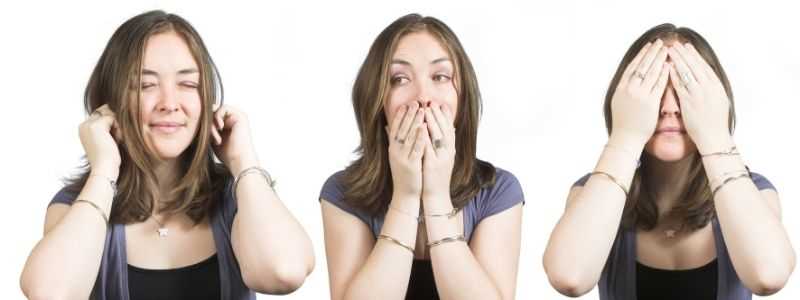If someone blinks rapidly during a conversation, what’s the most likely explanation?

Correct Answer: They’re feeling stressed or overwhelmed
While blinking can increase when lying (due to stress), it’s not a guaranteed lie detector. Rapid blinking more often signals anxiety, surprise, or mental overload. Dry eyes (D) can also cause blinking, but in body language studies, emotional stress is the usual culprit.
Salespeople are sometimes taught to check a customer's palms when they are talking. Exposed palms generally mean an honest response while hidden palms point to a potential lie.

Do Visible Palms Indicate Honesty in Sales?
Mostly true, but oversimplified
- Exposed palms often suggest openness (backed by Pease & Pease body language research)
- Hidden palms can indicate discomfort or concealment
- But it's not a guaranteed lie detector - some people naturally gesture less
Source: Pease, A. & Pease, B. (2004). The Definitive Book of Body Language (Chapter 3: "Palm Gestures")
Key point: Smart salespeople look for changes in palm visibility, not just absolute positions.
What does frequent "self-touching" (like rubbing arms or playing with hair) typically indicate?

Correct Answer: Nervousness or discomfort
Why? Self-touching (or "pacifying gestures") often signals stress or anxiety. When people feel uneasy, they subconsciously comfort themselves by rubbing their arms, touching their neck, or playing with their hair. However, context matters—some people do it out of habit!
Most speakers use a finger pointing position when speaking because it is percived in a positive way by people in the audience.

A finger pointed position only gets a positive response rate of 28%
a palm down position gets 52% positive ratings
and palm up/exposed positon gets 82% positive responses
When someone mirrors your body language (e.g., crossing legs when you do), this usually means:

Correct Answer: They feel a connection or rapport with you
Mirroring is a subconscious sign of liking and agreement. When people naturally match your posture or gestures, it means they’re engaged and comfortable with you. Salespeople and negotiators often use this deliberately to build trust!
Advertisement
Studies show that this sex initiates the first move in a relationship 90% of the time.

While men often make the obvious first move (asking someone out, approaching directly), women initiate 90% of encounters through body language signals (e.g., eye contact, smiling, preening, proximity). These nonverbal cues are the "green light" that encourage men to approach. Men may think they made the first move, but studies cited by the Peases show that women subconsciously control the opening stages of attraction by sending signals that invite approach.
The Wharton study in the United States found that the retention of verbal presentations was only 10%.

The Wharton Study on Presentation Retention
A study conducted by Wharton School of Business in the United States found that:
- The retention rate for verbal-only presentations was only 10%
- Retention improved significantly when visual aids were added to presentations
Key implications: This demonstrates the importance of incorporating visual elements to enhance information retention in professional and educational settings.
Researcher Robert Provine found that only 15% of laughter has to do with the actual jokes and much more with bonding and relationship building.

Only 10-15% of laughter is triggered by actual jokes (Provine, 2000).
Most laughter occurs in everyday conversations, like:
Friendly greetings ("Hey! Good to see you!")
Nervous reactions (awkward pauses)
Social bonding (group laughter, even when nothing’s funny)
Try forcing yourself to laugh right now—your mood will likely improve. That’s because laughter evolved as social signaling, not just humor response.
Research has proven that you can tell if someone is remembering something they have seen, heard, smelled, tasted or touched by the movement of their eyes.

1. The NLP Eye-Accessing Cues Theory
According to Neuro-Linguistic Programming (NLP):
- Up & Left (Right-handed people) → Remembering a visual image.
- Up & Right → Constructing an image (imagining).
- Sideways Left → Remembering sounds.
- Sideways Right → Constructing sounds.
- Down & Left → Internal dialogue.
- Down & Right → Accessing feelings or kinesthetic memory.
Claim: Eye movements indicate whether someone is recalling a real memory or fabricating.
2. What Science Says
No Strong Empirical Support:
- A 2012 review in PLOS ONE found no reliable correlation between eye movements and memory type.
- University of Edinburgh (2015): Eye movements are more about spatial processing than memory retrieval.
Companies can increase the sale of their beauty products by using close up pictures of models and artificially enlarging their pupils.

In a direct mail campaign, Revlon increased lipsticks sales by 45% by enlarging the pupil sizes of the models in the photographs. Studies show people perceive faces with larger pupils as more attractive and trustworthy (e.g., PLOS ONE, 2013).
Advertisement
Research has proven that most people look away from the face of the person they are lying to.

While people assume liars look away, studies (e.g., The Journal of Nonverbal Behavior) show that liars often overcompensate by holding eye contact longer than usual to mask their deceit.
Research has shown that when dating a man-women are more attracted to someone who can make them laugh.

Multiple studies confirm that women consistently rate humor as one of the most attractive traits in a potential partner. A 2015 study in Evolutionary Psychology found that women prioritize a man’s ability to make them laugh over looks in long-term relationships. Why? Humor signals intelligence, creativity, and social confidence—qualities linked to better survival and parenting skills (evolutionary psychology explanation).
Research has shown that women are triggered visually by a certain part of a mans' body. Which part of the body are most women attracted to?

According to Allan and Barbara Pease in The Definitive Book of Body Language, their research and surveys indicate that women are most visually attracted to a man’s buttocks (40%), with the remaining 60% split among other features like shoulders, chest, and legs.
Shoulders & V-Shape Torso (~20-25%): Signals protection ability.
Legs & Thighs (~15%): Power and athleticism.
Chest/Arms (~10-15%): Moderate muscularity preferred.
Studies have shown that if a woman television host wears a short dress, men will watch the programming longer but remember less of what was said.

What Happens When Female TV Hosts Wear Short Dresses?
- Men watch longer when the host wears a short dress
- But they remember less of what she says
- Their attention goes to her looks instead of the information
Source: Journal of Broadcasting & Electronic Media (2013 study on attire effects)
Why this matters: Looks can grab attention, but might make the message harder to remember.
Which of the following is NOT one of the 8 most common lying gestures?





